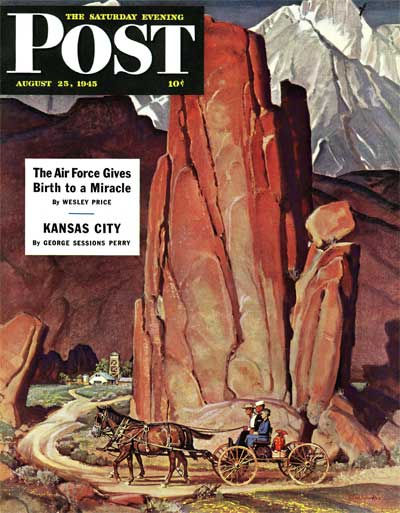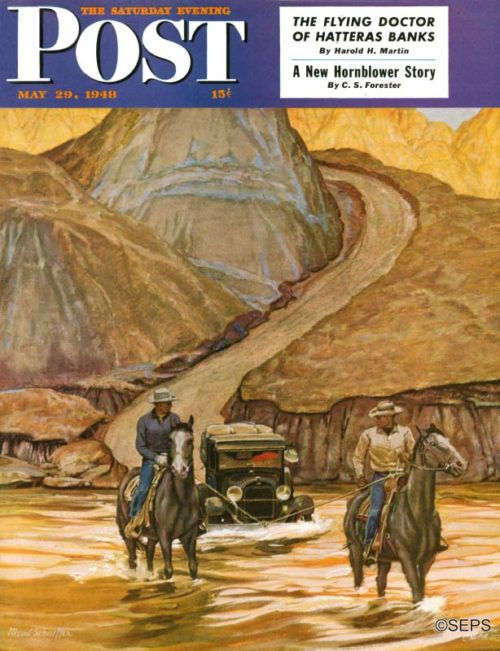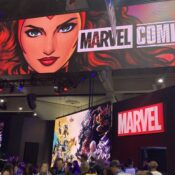
Back before Google Maps gave us satellite images of every corner of America, there was Mead Schaeffer.
Schaeffer (1898–1980), whose cover illustrations appeared from 1942 to 1953, was one of the most highly regarded cover artists for The Saturday Evening Post. During World War II, he became famous for his war covers, but as the war ended, he needed to find a new theme. Soldiers were returning home to small villages and hamlets across the country, and the nation’s focus was returning once again to domestic life. Schaeffer’s wife, Elizabeth, who also served as his business manager and photographer, suggested that he paint a series of “regional covers” focusing on daily life in post-war America.
The Post jumped at the idea, and soon the Schaeffers were on the road, looking for scenes to feature on the cover of the magazine. His first cover in the series, published in November 1944, was a rural barn dance.

November 25, 1944
This was followed in February by a winter scene of Vermont citizens making maple syrup.

February 17, 1945
Next, he painted a sailor returning to his family ranch in Lone Pine, California.

August 25, 1945
And in quick succession, he depicted a Maine lobsterman, a chuckwagon cook in Texas, moss pickers in Louisiana, and shrimpers in Mississippi.

March 9, 1946

September 14, 1946″

April 5, 1947

October 25, 1947
The Post called these covers “our family album of American regions.” Illustration expert Fred Taraba wrote in Masters of American Illustration that this series was designed to give viewers “a sense of the overall grandeur and diversity of the U.S.”
The regional covers became so popular that they created unexpected complications for Schaeffer: Communities began competing for his attention. When Schaeffer and his wife flew to Oklahoma City to paint workers on an oil rig, they were intercepted at the airport by a police motorcade, which gave them a tour of the city to show off possible sites for paintings. Local officials then escorted the couple to a plush hotel, where the mayor informed him the city would pay for all his expenses and transportation. The mayor next tried to set up a series of public appearances, but Schaeffer fended them off and spent a week painting on a grimy oil rig.

November 9, 1946
When he arrived in North Dakota to paint the Little Muddy River, Schaeffer was ushered into the capitol to meet the governor, who wanted to make sure his state would be well represented on the cover of the Post.

May 29, 1948

September 29, 1945
Schaeffer’s regional covers introduced a national audience to parts of the country they’d never seen before. TV only offered grainy black-and-white images, and there was no internet in those days, but Schaeffer’s sharp, realistic paintings gave the nation images to preserve in their memories. Most of all, delighted readers who lived in the region selected for the cover would go over every detail and write to the Post commenting on accuracy or making suggestions. They rarely found mistakes, thanks to Schaeffer’s passion for “getting it right.”
The Post was one of America’s most popular “general appeal” magazines, designed to be read by the country as a whole. And its weekly efforts to identify the largest common core of the country might have helped homogenize the nation. In later years, there was some concern that even the Post was becoming more eastern and elitist in its focus. That’s one reason why the magazine welcomed Schaeffer’s regional series. It was perceived as way of rejuvenating the Post’s nationwide outlook. Communities from all around America felt legitimized and important when they appeared in Schaeffer’s paintings on the cover of the Post.
Learn more about artist Mead Schaeffer.
See more of David Apatoff’s art columns.
Become a Saturday Evening Post member and enjoy unlimited access. Subscribe now




Comments
My grandfather and great grandfather are the two men depicted in “Lobstermen”. Our family has tried to locate the original painting and prints for years with only a few successes finding some old covers of that issue of the post. It would be amazing to locate the painting would be a dream come true.
Bob McGowan jr.– Thanks for chiming in. You clearly have a valuable perspective on these illustrators to contribute.
I agree 100%, Schaeffer’s famous World War II series was an important collection of paintings. He researched the heck out of them to make sure he got every tiny detail correct. The series was popular with wartime audiences, and the originals are still on display together in Texas, many years later. But the series was in a highly detailed, nearly photographic style very different from the work Schaeffer had done before or that he would do after.
A fascinating look at arguably one of the Post’s most important artists in the ’40s. I never realized the Post was perceived (by some) as being too “East coast-ish” in the mid-’40s, and the story of how he helped get things back on course with his ‘regional’ series!
What I did know (basically guessed on my own) was that during World War II Mead Schaeffer was a HUGE weapon against LIFE magazine in depicting what many soldiers were facing on the battlefield. Mead Schaeffer’s war covers were artwork in color, but pulled no punches, and didn’t sugar coat anything even though it wasn’t photography. Like many of Norman Rockwell’s later covers, Mead Schaeffer’s war covers came eerily close to photography.
The covers highlighted here show the diversity of his style, so much so you might not realize they were all done by Scheaffer otherwise. Fantastic then, even more so now.